skip to main |
skip to sidebar
My entire family likes this vegetable, but my sister and I, we're "lattoo" (Hindi slang for "crazy") when it comes to vazhakkai. If we were asked to eat it every day for a year, we would probably beg to have it twice a day! The recipe below is how my mother makes it, and I see no reason to mess with something that I think is perfect. The flavour that the coconut oil gives this vegetable is unbelievable. The two just go together, no question.
That said, if when I get my hands on vazhakkai again, I hope to make a recipe that I've had in my folder for literally years, involving fresh mustard paste. You would think I could hold back at least one vazhakkai for the mustardy recipe... but no. I haven't yet made it because each time I end up making this same one. This dry fry with my mother's thengai kuzhambu (South Indian coconut-and-fenugreek-seed gravy)and steamed rice - I couldn't want for more!
Recipe for: Vazhakkai fry
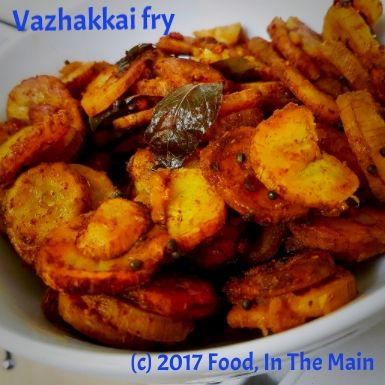
Ingredients:
3 green (raw) bananas
2 tbsp coconut oil
A few fresh/frozen curry leaves (optional)
1/4 tsp turmeric powder
1/8 tsp asafoetida powder (optional)
1/2 tsp urad dal
1 tsp mustard seeds
1/4 tsp black pepper powder
Red chilli powder to taste
Salt to taste
1 tsp tamarind paste
Method:
1. Wear disposable gloves or grease your hands with oil before peeling the bananas as the sap will otherwise stick to your hands. Make sure to get all the thick green skin off the bananas.
2. Slice the bananas into even slices about 1/4cm thick and put them in a saucepan of water. The water should be enough to cover the slices generously. Dissolve the tamarind paste and turmeric powder in the water.
3. Parboil the sliced bananas, then place in a colander to drain off the cooking water. Handle carefully so that the slices don't break up too much.
4. Heat the coconut oil in a wide saucepan, then add the mustard seeds, curry leaves and urad dal. Cover and let the seeds splutter. The urad dal should be golden by now.
5. Now add the chilli powder and black pepper powder, stir it for 20 seconds, then add the parboiled banana slices along with salt to taste. Stir carefully to coat the slices evenly.
6. Cover the pan and let the slices roast for 8-10 minutes on a medium heat, until the slices turn golden and are fully cooked. Turn the slices carefully over and let them roast for about 5 minutes more. Serve hot as a side with rice, rasam or sambar and any South Indian "gravy" like moar kuzhambu, vattha kuzhambu or thengai kuzhambu (recipes for all these are on my blog).
I simply had to post this kuzhambu recipe, because it is just literally so lip-smackingly good - thick, tangy, hot, spicy, a tiny bit sweet and entirely irresistible! The recipe is from a foodie group on Facebook of which I am a member, and I can't seem to find it again on FB (which I wanted to do for crediting purposes on my blog). I am SO pleased that I wrote it down on a piece of paper when I saw it on FB (not having had access to a printer or my own computer at that point). I state freely that this is not my own recipe, and I do really wish I knew whose it was. All I DO know for certain that it is comfort food whose ingredients are good for health.
I made the kuzhambu and refrigerated it just before going on a week-long trip on a narrowboat with my husband. It was a lovely, relaxing, stressfree holiday, with the most gorgeous, eye-poppingly pretty scenery... but that's only by the way. The main thing is, I knew that the food I would be eating on the boat (and off it, at the various canal-side pubs that we stopped at) would not be spicy enough for me, and I would be dying for something to tickle my palate when we got back.
And so it turned out.
I certainly enjoyed the food en route, but I couldn't wait to get stuck into hot and spicy comfort food when we got home - and this kuzhambu was absolutely just the thing. I could not have asked for anything better. All I had to do was make some rice - and because it was too late to make any vegetable side-dish to accompany it (and because I was much too hungry), I just microwaved a couple of poppadoms and ladled the kuzhambu on the rice. It tasted like heaven - but there was rather too much of the kuzhambu on the rice, because it was so full-on hot and peppery. It's really meant to be mixed with rice in small amounts, not in quantities like regular sambar or rasam. I had to tone the spice quotient down somewhat with a large dollop of Greek yogurt on the side of my plate, but that was a wonderful combination anyway.
Oh, and if you're wondering why I didn't mention the taste of the large amounts of garlic that went into the kuzhambu, it's because it doesn't come across as overly garlicky. So don't worry about it, and don't skimp on the garlic; in fact, next time I will probably add even more garlic. It's good for you, anyway, so no harm done.
One other thing - the correct amount of salt is essential, otherwise the kuzhambu tends to be on the sweetish side. I'm used to making do with less salt in my cooking than (after all, you can always add more, but you can't really undo oversalting disasters!) but in this case I did have to add some more. So, it would probably be best to start by adding 3/4 tsp salt, then taste-testing to see if your palate requires more. Let your tongue and palate be the judge.
Happy eating!
Recipe for: Black pepper garlic kuzhambu
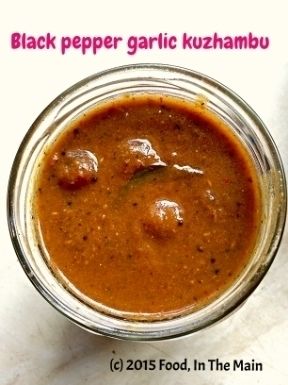
Ingredients:
1/4 cup baby shallots/sambar onions
1 tbsp tamarind paste, dissolved in 1/2 cup water
1/2 tsp turmeric powder
1 tsp jaggery (raw palm sugar) (optional)
1 tbsp neutral oil
Salt to taste
To grind:
1-2 tsp black peppercorns (more if you love your black pepper)
6-8 dried red chillies
1 whole head of garlic (about 1/8 cup garlic cloves, peeled and chopped into chunks if very large)
2 tsp cumin seeds
1 medium onion
1 medium tomato
3 sprigs curry leaves
To temper:
1 tbsp nallennai (unrefined sesame oil)
1/2 tsp vendhayam (methi/fenugreek seeds)
2 tsp mustard seeds
10 curry leaves
Method:
1. Heat 1/2 tbsp oil in a small pan and add the first four items on the "To grind" list. Saute for 2-3 minutes on med-high, stirring, until the chillies turn a darker shade of red and the garlic is starting to turn colour. Then add the remaining ingredients and fry until the garlic is golden. Allow to cool, then grind to a smooth paste. Set aside till required.
2. Heat the remaining neutral oil, add the small onions and fry till golden (approx 3-4 minutes). Add the tamarind water, salt to taste, turmeric and jaggery. Bring it to a boil and let it bubble for 2 minutes.
3. Now add the ground paste and 2 cups water and mix well. Bring to a boil again and let it simmer for 10 minutes, or until it is thick enough to coat the back of a spoon.
4. As a final touch, heat the nallennai in a small pan, then add the mustard seeds and curry leaves. Cover and let the mustard seeds pop. Now tip in the fenugreek seeds and fry for 30 seconds or until the seeds turn a darker shade of brown. Be careful not to burn the seeds or they will be horribly bitter. Pour the tempering over the kuzhambu and stir it in. Let it simmer for another 3 minutes, then take the pan off the heat.
Serve sparingly over steamed white rice with a dollop of ghee, any dry vegetable curry and microwaved poppadoms.
This gorgeous emerald coloured chutney is many kinds of pretty - pretty beautiful, pretty tasty, pretty versatile, pretty healthy, pretty easy to make...
So go and make it. Pretty please.
Recipe for: Spinach-onion-cabbage chutney

Ingredients:
1 cup spinach leaves
1/2 cup cabbage, sliced
1 medium onion, sliced
A good handful of chives
2 cloves garlic, sliced
1 tbsp oil
2 tsp urad dal
1 tsp tamarind paste or a gooseberry sized piece of tamarind
5-6 dried red chillies (or to taste)
1/4 tsp asafoetida powder (optional)
2 tsp mustard seeds
4-5 fresh or frozen curry leaves
Salt to taste
Method:
1. Heat the oil and when it shimmers, add the mustard seeds and cover the pan till they finish popping.
2. Now add the urad dal, red chillies, curry leaves and asafoetida powder. Stir-fry till the urad dal turns a pale golden brown and the red chillies are a shiny darker shade.
3. Add the garlic, chives and onion and stir-fry till the onions start to soften and turn translucent.
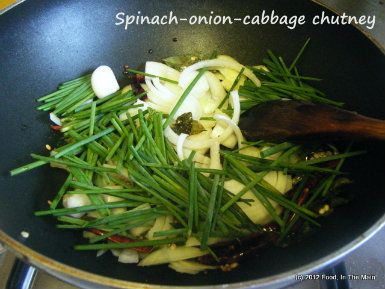
4. Add the cabbage and fry it till it wilts,
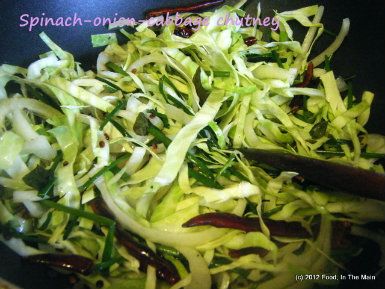
then the spinach until it wilts too.

Let this mixture cool.
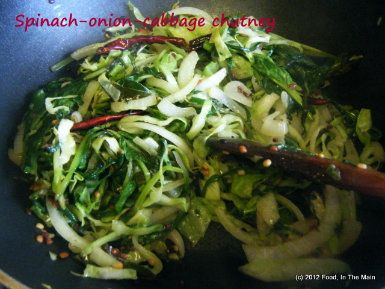
5. Pick out the red chillies and grind them to a smooth paste with the tamarind and a couple of spoonfuls of the vegetable mixture.
6. Now add the rest of the cabbage-onion-spinach mix
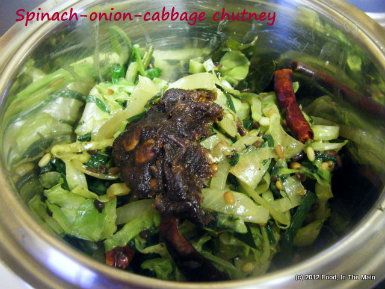
and grind it to a fairly smooth consistency - but not to a puree. It should be a little bit coarse.
7. Remove the chutney to a bowl, add salt to taste and mix well. This can be mixed with rice or eaten as a side dish/dip with chapaties, dosas, idlis etc.
RECIPE: SPINACH-ONION-CABBAGE CHUTNEY
Ingredients:
1 cup spinach leaves
1/2 cup cabbage, sliced
1 medium onion, sliced
A good handful of chives
2 cloves garlic, sliced
1 tbsp oil
2 tsp urad dal
1 tsp tamarind paste or a gooseberry sized piece of tamarind
5-6 dried red chillies (or to taste)
1/4 tsp asafoetida powder (optional)
2 tsp mustard seeds
4-5 fresh or frozen curry leaves
Salt to taste
Method:
1. Heat the oil and when it shimmers, add the mustard seeds and cover the pan till they finish popping.
2. Now add the urad dal, red chillies, curry leaves and asafoetida powder. Stir-fry till the urad dal turns a pale golden brown and the red chillies are a shiny darker shade.
3. Add the garlic, chive and onion and stir-fry till the onions start to soften and turn translucent.
4. Add the cabbage and fry it till it wilts, then the spinach until it wilts too. Let this mixture cool.
5. Pick out the red chillies and grind them to a smooth paste with the tamarind and a couple of spoonfuls of the vegetable mixture..
6. Now add the rest of the cabbage-onion-spinach mix and grind it to a fairly smooth consistency - but not to a puree. It should be a little bit coarse.
7. Remove the chutney to a bowl, add salt to taste and mix well. This can be mixed with rice or eaten as a side dish/dip with chapaties, dosas, idlis etc.
You know, it's really nice not to be the proverbial frog in the well, and it's all the hundreds of food blogs that I have to thank for introducing me to the enticing, amazing world of home-style food recipes... and showing me the thousands of possibilities with everyday vegetables and fruit that would never have occurred to me otherwise.
Take thogayal, for instance - I knew three kinds: Coconut-only, coconut-with-cabbage, and coconut-with-pumpkin-or-chayote squash. I didn't even imagine that thogayal could be made with carrots, beets, bell peppers, spinach, etc... and as for making it without coconut - wow! The first time I made thogayal with just cabbage was such a revelation! All the taste of the dish I loved without loading it up with coconut - I can't tell you how much I loved it.
In that spirit, I decided to make thogayal with a bunch of red radishes with their greens because I didn't feel like eating them raw (they were pretty pungent!).
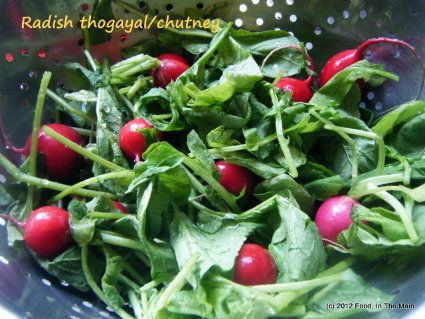
I was actually a bit worried that the thogayal would be smelly... but as it turned out, you would not have known that it was made with radishes, because the typical smell of the radishes was totally gone. I'm absolutely certain that even radish haters would love this chutney. You could probably even try it with the more typically Indian white radish or mooli - I'm going to do so if and when I get my hands on some. But until then, red radish thogayal will fill its place perfectly.
Recipe for: Radish thogayal/chutney
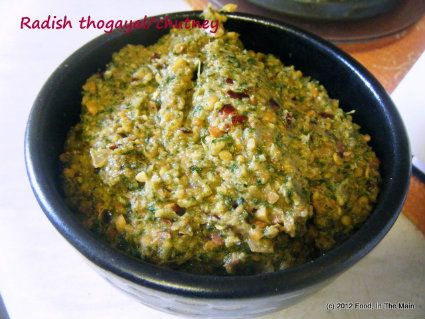
Ingredients:
10-12 small red radishes or 1 medium white mooli/radish, chopped
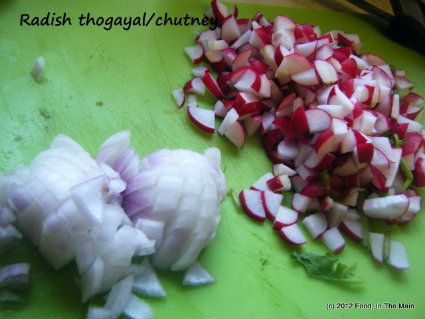
1 cup radish greens (or use spinach) (optional)
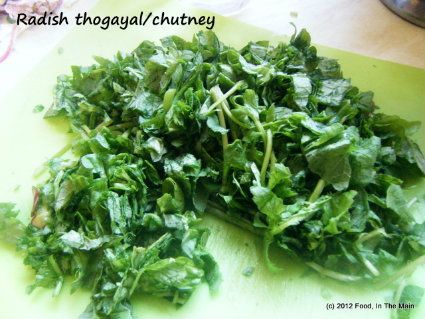
2 medium onions, chopped
5-6 dried red chillies (or to taste)
2 tbsp tur/toor/tuvar dal
3 tbsp urad dal

1 tbsp tamarind paste
a few fresh/frozen curry leaves
3 tsp oil
1/2 tsp asafoetida powder (optional)
Salt to taste
Method:
1. Heat 1 tsp oil in a pan, add the asafoetida powder and let it sizzle, then add the chopped onions and radish.
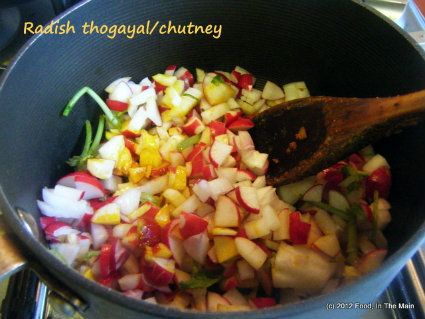
Stir-fry over medium heat for 3-4 minutes, until the radish is nearly cooked and the onions are turning soft (6-7 minutes).
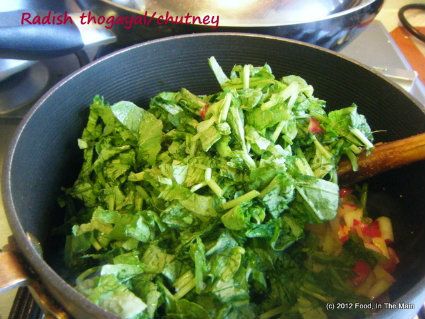 Add the chopped greens and cook till they wilt. Remove from the heat and let cool.
Add the chopped greens and cook till they wilt. Remove from the heat and let cool.
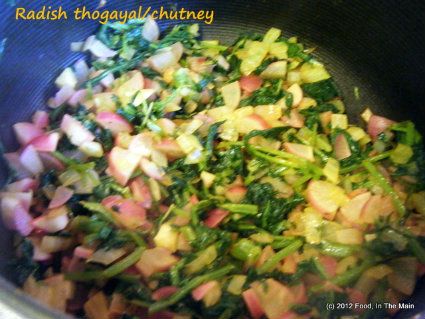 2. In another small pan, heat the remaining oil and add the red chillies, urad dal, toor dal and curry leaves.
2. In another small pan, heat the remaining oil and add the red chillies, urad dal, toor dal and curry leaves.
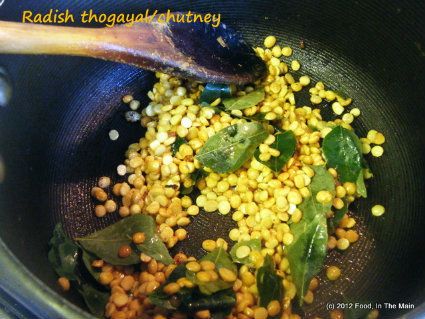 Fry, stirring, till the dals are golden brown and the red chillies turn a shade darker. Remove from the heat.
3. When all of it is completely cool, transfer to a mixie/grinder, add the tamarind paste and grind it to a fairly smooth mix.
Fry, stirring, till the dals are golden brown and the red chillies turn a shade darker. Remove from the heat.
3. When all of it is completely cool, transfer to a mixie/grinder, add the tamarind paste and grind it to a fairly smooth mix.
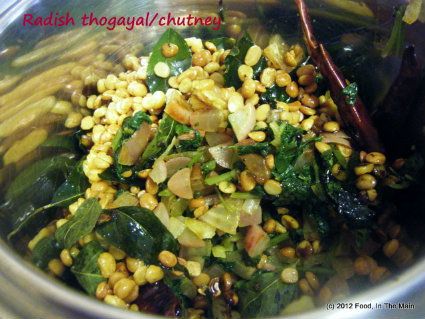 4. Add salt to taste and mix it in. Serve as a side dish with rice, chapaties, bread or as a dip with snacks.
RECIPE: RADISH THOGAYAL/CHUTNEY
4. Add salt to taste and mix it in. Serve as a side dish with rice, chapaties, bread or as a dip with snacks.
RECIPE: RADISH THOGAYAL/CHUTNEY
Ingredients:
10-12 small red radishes or 1 medium white mooli/radish, chopped
1 cup radish greens (or use spinach) (optional)
2 medium onions, chopped
5-6 dried red chillies (or to taste)
2 tbsp tur/toor/tuvar dal
3 tbsp urad dal
1 tbsp tamarind paste
a few fresh/frozen curry leaves
3 tsp oil
1/2 tsp asafoetida powder (optional)
Salt to taste
Method:
1. Heat 1 tsp oil in a pan, add the asafoetida powder and let it sizzle, then add the chopped onions and radish. Stir-fry over medium heat for 3-4 minutes, until the radish is nearly cooked and the onions are turning soft (6-7 minutes). Add the chopped greens and cook till they wilt. Remove from the heat and let cool.
2. In another small pan, heat the remaining oil and add the red chillies, urad dal, toor dal and curry leaves. Fry, stirring, till the dals are golden brown and the red chillies turn a shade darker. Remove from the heat.
3. When all of it is completely cool, transfer to a mixie/grinder, add the tamarind paste and grind it to a fairly smooth mix.
4. Add salt to taste and mix it in. Serve as a side dish with rice, chapaties, bread or even as a dip with snacks.
Until my mother mentioned it, I didn’t know that kothavarakkai (cluster beans) could even be made into kootu (although, thinking about it, there’s no reason why not – it’s just that it never occurred to me).
This kootu, however, is quite different from the other kootu recipes I’ve posted so far. I probably wouldn’t have liked it as a kid (preferring it as usili above all, because kothavarakkai has a mild bitterness to it that the dal disguised). But, as a more discerning adult, I have to say I welcomed the chance to learn another way to prepare this vegetable. It was definitely to my taste, what with all the kadalai paruppu in it, but my mother was dissatisfied because she felt it would’ve been better with less of that particular dal.
We’ve agreed to disagree on the issue.
Recipe for: Kothavarakkai kootu
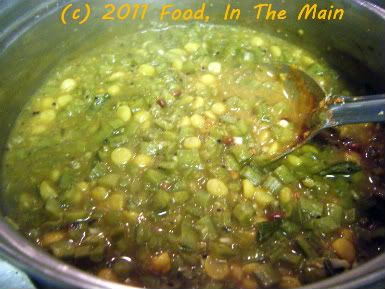 Ingredients:
2 cups kothavarakkai, chopped
Ingredients:
2 cups kothavarakkai, chopped
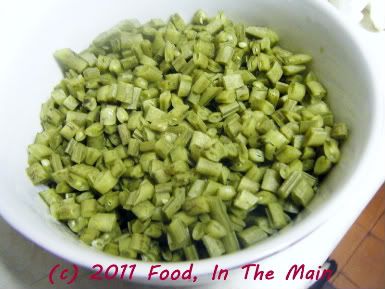 1/4 cup masoor dal, cooked and mashed
1/4 cup chana dal/kadalai paruppu, soaked for 15 minutes
1 tsp tamarind paste dissolved in 2 cups water
1/4 cup masoor dal, cooked and mashed
1/4 cup chana dal/kadalai paruppu, soaked for 15 minutes
1 tsp tamarind paste dissolved in 2 cups water
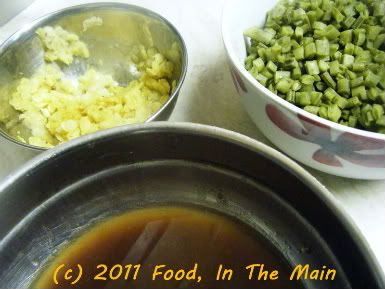 2-3 tbsp finely grated coconut
2 tsp oil
2 heaped tsp sambar powder
1 tsp coriander powder
1 tsp brown mustard seeds
1 tbsp whole urad dal (or regular broken urad dal if you don't have whole)
1/4 tsp asafoetida powder
a few fresh curry leaves, torn up
1 tbsp rice flour
Salt to taste
2-3 tbsp finely grated coconut
2 tsp oil
2 heaped tsp sambar powder
1 tsp coriander powder
1 tsp brown mustard seeds
1 tbsp whole urad dal (or regular broken urad dal if you don't have whole)
1/4 tsp asafoetida powder
a few fresh curry leaves, torn up
1 tbsp rice flour
Salt to taste
Method:
1. Pressure cook the kothavarakkai with 2 cups tamarind water (3 whistles) or microwave (8-10 minutes in an 800W oven on full power). You can also cook it on the hob with 2 cups tamarind water till the vegetable is soft.
2. Cook the soaked chana dal/kadalai paruppu in 1 cup water on the hob until it is cooked but still retains its shape (should be able to easily squash the dal between your finger and thumb). There should not be too much water left.
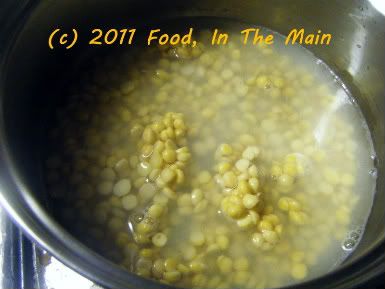 3. Add the kothavarakkai to the chana dal along with the cooking water. The liquid level should be just enough to cover the dal and vegetable (you can add more water if required).
3. Add the kothavarakkai to the chana dal along with the cooking water. The liquid level should be just enough to cover the dal and vegetable (you can add more water if required).
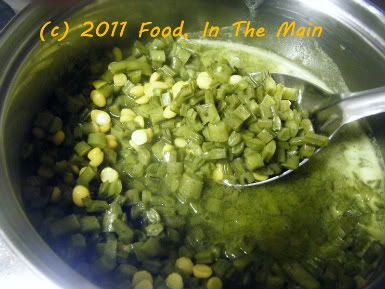 4. Add two heaped tsp sambar powder and stir it in.
4. Add two heaped tsp sambar powder and stir it in.
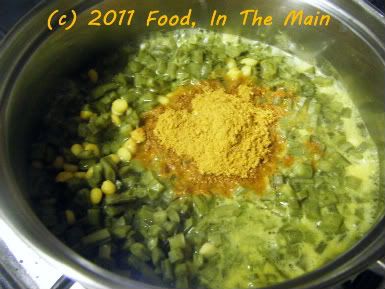 5. Add salt to taste and stir that in too.
5. Add salt to taste and stir that in too.
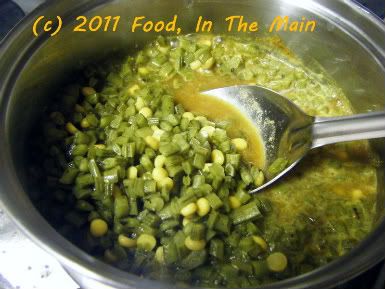 6. Mix the cooked masoor dal and 1 tbsp rice flour with some water from the pan itself, to make a pourable paste, and mix that in with the kothavarakkai in the pan.
6. Mix the cooked masoor dal and 1 tbsp rice flour with some water from the pan itself, to make a pourable paste, and mix that in with the kothavarakkai in the pan.
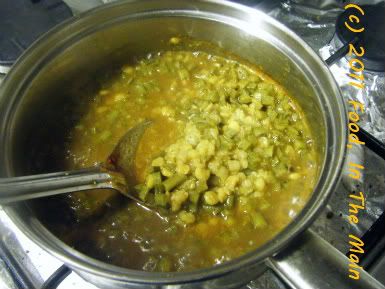 Let this simmer on medium-low heat for 5 minutes.
7. In the meantime, heat 2 tsp oil in a small pan. Add the asafoetida powder, 1 tbsp whole urad dal, 1 tsp mustard seeds, the curry leaves and 1 tsp coriander powder and let it fry for 30-40 seconds on medium-high heat. When the urad dal starts turning a lovely reddish colour, add the grated coconut and fry till it begins to get a pale brown tinge and smells nutty and fried.
Let this simmer on medium-low heat for 5 minutes.
7. In the meantime, heat 2 tsp oil in a small pan. Add the asafoetida powder, 1 tbsp whole urad dal, 1 tsp mustard seeds, the curry leaves and 1 tsp coriander powder and let it fry for 30-40 seconds on medium-high heat. When the urad dal starts turning a lovely reddish colour, add the grated coconut and fry till it begins to get a pale brown tinge and smells nutty and fried.
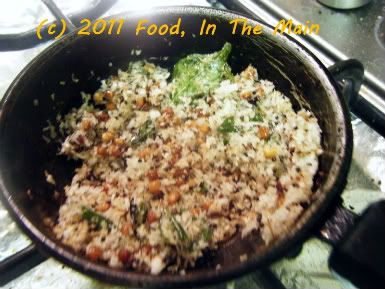 8. Add the fried coconut mix immediately to the kothavarakkai and stir it in.
8. Add the fried coconut mix immediately to the kothavarakkai and stir it in.
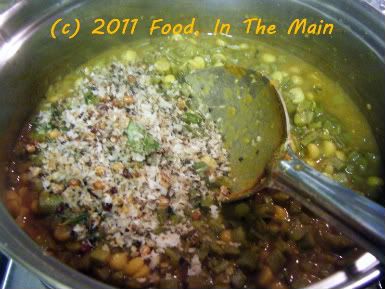 Bring the kootu to a boil and let it remain on high heat for 2 minutes. Then take it off the heat and let it rest for 10 minutes. Serve warm with steamed white rice and appalam or vadam and any pickle.
RECIPE: KOTHAVARAKKAI KOOTU
Ingredients:
2 cups kothavarakkai, chopped
1/4 cup masoor dal, cooked and mashed
1/4 cup chana dal, soaked for 15 minutes
1 tsp tamarind paste dissolved in 2 cups water
2-3 tbsp finely grated coconut
2 tsp oil
2 heaped tsp sambar powder
1 tsp coriander powder
1 tsp brown mustard seeds
1 tbsp whole urad dal (or regular broken urad dal if you don't have whole)
1/4 tsp asafoetida powder
a few fresh curry leaves, torn up
1 tbsp rice flour
Salt to taste
Method:
1. Pressure cook the kothavarakkai with 2 cups tamarind water (3 whistles) or microwave (8-10 minutes in an 800W oven on full power). You can also cook it on the hob with 2 cups tamarind water till the vegetable is soft.
2. Cook the soaked chana dal/kadalai paruppu in 1 cup water on the hob until it is cooked but still retains its shape (should be able to easily squash the dal between your finger and thumb). There should not be too much water left.
3. Add the kothavarakkai to the chana dal along with the cooking water. The liquid level should be just enough to cover the dal and vegetable (you can add more water if required).
4. Add two heaped tsp sambar powder and stir it in.
5. Add salt to taste and stir that in too.
6. Mix the cooked masoor dal and 1 tbsp rice flour with some water from the pan itself, to make a pourable paste, and mix that in with the kothavarakkai in the pan. Let this simmer on medium-low heat for 5 minutes.
7. In the meantime, heat 2 tsp oil in a small pan. Add the asafoetida powder, 1 tbsp whole urad dal, 1 tsp mustard seeds, the curry leaves and 1 tsp coriander powder and let it fry for 30-40 seconds on medium-high heat. When the urad dal starts turning a lovely reddish colour, add the grated coconut and fry till it begins to get a pale brown tinge and smells nutty and fried.
8. Add the fried coconut mix immediately to the kothavarakkai and stir it in. Bring the kootu to a boil and let it remain on high heat for 2 minutes. Switch off the heat and serve warm with steamed white rice and appalam or vadam and any pickle.
Bring the kootu to a boil and let it remain on high heat for 2 minutes. Then take it off the heat and let it rest for 10 minutes. Serve warm with steamed white rice and appalam or vadam and any pickle.
RECIPE: KOTHAVARAKKAI KOOTU
Ingredients:
2 cups kothavarakkai, chopped
1/4 cup masoor dal, cooked and mashed
1/4 cup chana dal, soaked for 15 minutes
1 tsp tamarind paste dissolved in 2 cups water
2-3 tbsp finely grated coconut
2 tsp oil
2 heaped tsp sambar powder
1 tsp coriander powder
1 tsp brown mustard seeds
1 tbsp whole urad dal (or regular broken urad dal if you don't have whole)
1/4 tsp asafoetida powder
a few fresh curry leaves, torn up
1 tbsp rice flour
Salt to taste
Method:
1. Pressure cook the kothavarakkai with 2 cups tamarind water (3 whistles) or microwave (8-10 minutes in an 800W oven on full power). You can also cook it on the hob with 2 cups tamarind water till the vegetable is soft.
2. Cook the soaked chana dal/kadalai paruppu in 1 cup water on the hob until it is cooked but still retains its shape (should be able to easily squash the dal between your finger and thumb). There should not be too much water left.
3. Add the kothavarakkai to the chana dal along with the cooking water. The liquid level should be just enough to cover the dal and vegetable (you can add more water if required).
4. Add two heaped tsp sambar powder and stir it in.
5. Add salt to taste and stir that in too.
6. Mix the cooked masoor dal and 1 tbsp rice flour with some water from the pan itself, to make a pourable paste, and mix that in with the kothavarakkai in the pan. Let this simmer on medium-low heat for 5 minutes.
7. In the meantime, heat 2 tsp oil in a small pan. Add the asafoetida powder, 1 tbsp whole urad dal, 1 tsp mustard seeds, the curry leaves and 1 tsp coriander powder and let it fry for 30-40 seconds on medium-high heat. When the urad dal starts turning a lovely reddish colour, add the grated coconut and fry till it begins to get a pale brown tinge and smells nutty and fried.
8. Add the fried coconut mix immediately to the kothavarakkai and stir it in. Bring the kootu to a boil and let it remain on high heat for 2 minutes. Switch off the heat and serve warm with steamed white rice and appalam or vadam and any pickle.
Over the last few years, I’ve been testing my limits with that most unattractive of vegetables, the bittergourd (or karela, bitter melon, pavakkai or whatever name you call it – my husband terms them “rats”), to see just HOW much I love it.
I used to hate it completely, in any form, as a kid. In my late teens or thereabouts, I would as a concession eat them deep fried (yes, I know, very broad-minded of me) mainly because the ones from Hot Chips in Abhiramapuram were sensational.
Eventually, after a couple of decades, I got around to eating them pan-fried crisp, as a dry curry. After that things moved a lot more rapidly in the experimentation department, and I moved on to karela-without-frying-too-much, karela as a semi-dry curry cooked with onions and tomatoes, karela with mustard paste (a double-whammy in the strong flavour department).
While karela pitla (South Indian style) is probably not as scary as it used to be, or even as full-on as karela-with-mustard-paste, I still had to see if I'd like it - just to drive away the last of the childhood fear and hatred of the karela's bitter flavour. And, of course, I passed the test with flying colours, practically inhaling the pitla which my mother made a day or two before she left Shrewsbury.
The only karela-based item that I know I won't like is karela juice. Where that is concerned, I think I'm as blinkered as I ever was, with just one standard reaction: "No way Felipe." (Jose wasn't available.)
Recipe for: Bittergourd/karela/pavakkai pitla
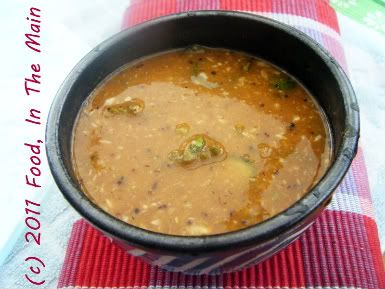
Ingredients:
2 medium karela/bittergourd/pavakkai, sliced into rounds
1 cup masoor dal, cooked
1 tbsp tamarind paste
3 tsp gingelly oil (or any neutral cooking oil)
1 tsp mustard seeds
2 tbsp sambar powder
2 tbsp finely grated coconut
1/2 tsp asafoetida powder
1 tbsp rice flour
Salt to taste
a few fresh curry leaves, torn up
3-4 cups water
Method:
1. Heat the oil in a small pan and add the asafoetida powder, mustard seeds and curry leaves.
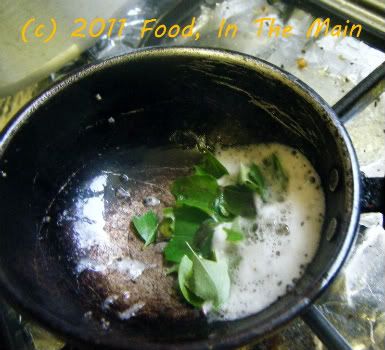 Cover and let the seeds pop, then add the grated coconut.
Cover and let the seeds pop, then add the grated coconut.  Fry on medium heat till the coconut is light brown and aromatic.
Fry on medium heat till the coconut is light brown and aromatic. 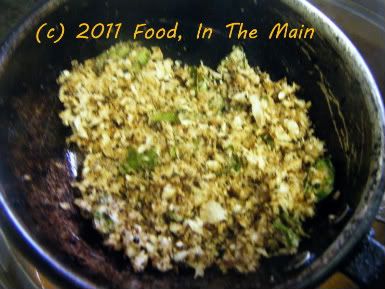 Remove from heat and set aside till required.
2. Put about a cupful of water in a pan along with the karela/bittergourd/pavakkai and turmeric powder.
Remove from heat and set aside till required.
2. Put about a cupful of water in a pan along with the karela/bittergourd/pavakkai and turmeric powder. 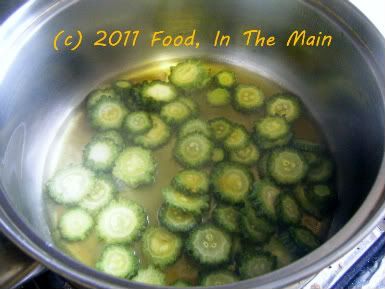 Let it cook till it becomes soft.
3. Dissolve the tamarind paste in 2 cup water and add it to the cooked karela/bittergourd/pavakkai.
Let it cook till it becomes soft.
3. Dissolve the tamarind paste in 2 cup water and add it to the cooked karela/bittergourd/pavakkai.
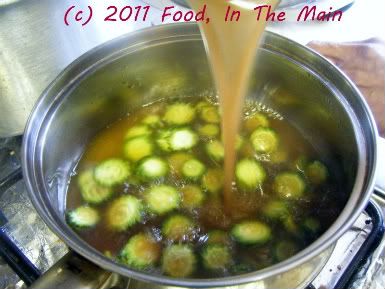 4. Bring this to a boil, then add the sambar powder and rice powder and stir till well mixed.
4. Bring this to a boil, then add the sambar powder and rice powder and stir till well mixed.
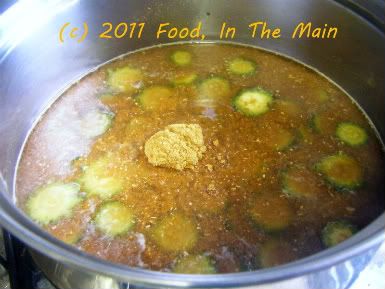 5. Stir in the cooked masoor dal
5. Stir in the cooked masoor dal 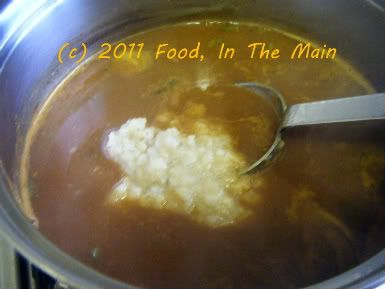 6. Add salt to taste along with the roasted coconut and mix in.
6. Add salt to taste along with the roasted coconut and mix in. 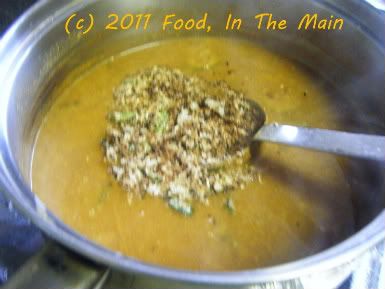 7. Boil the pitla for a few minutes longer till it thickens.
7. Boil the pitla for a few minutes longer till it thickens. 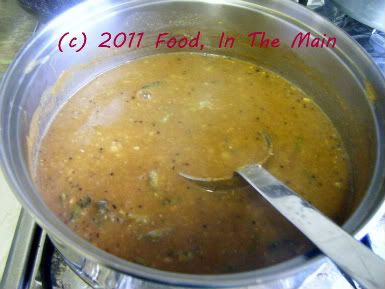 Serve hot with rice.
Serve hot with rice. 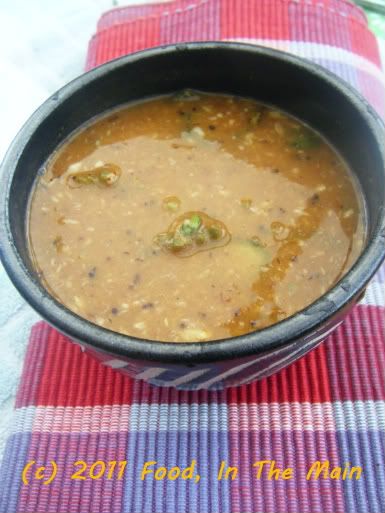 RECIPE: BITTERGOURD/KARELA/PAVAKKAI PITLA
Ingredients:
2 medium karela/bittergourd/pavakkai, sliced into rounds
1 tbsp tamarind paste
3 tsp gingelly oil (or any neutral cooking oil)
1 tsp mustard seeds
2 tbsp sambar powder
2 tbsp finely grated coconut
1/2 tsp asafoetida powder
1 tbsp rice flour
Salt to taste
a few fresh curry leaves, torn up
3-4 cups water
Method:
1. Heat the oil in a small pan and add the asafoetida powder, mustard seeds and curry leaves. Cover and let the seeds pop, then add the grated coconut. Fry on medium heat till the coconut is light brown and aromatic. Remove from heat and set aside till required.
2. Put about a cupful of water in a pan along with the karela/bittergourd/pavakkai and turmeric powder. Let it cook till it becomes soft.
3. Dissolve the tamarind paste in 2 cup water and add it to the cooked karela/bittergourd/pavakkai.
4. Bring this to a boil, then add the sambar powder and rice powder and stir till well mixed.
5. Stir in the cooked masoor dal.
6. Add salt to taste along with the roasted coconut and mix in.
7. Boil the pitla for a couple of minutes longer. Serve hot with rice.
RECIPE: BITTERGOURD/KARELA/PAVAKKAI PITLA
Ingredients:
2 medium karela/bittergourd/pavakkai, sliced into rounds
1 tbsp tamarind paste
3 tsp gingelly oil (or any neutral cooking oil)
1 tsp mustard seeds
2 tbsp sambar powder
2 tbsp finely grated coconut
1/2 tsp asafoetida powder
1 tbsp rice flour
Salt to taste
a few fresh curry leaves, torn up
3-4 cups water
Method:
1. Heat the oil in a small pan and add the asafoetida powder, mustard seeds and curry leaves. Cover and let the seeds pop, then add the grated coconut. Fry on medium heat till the coconut is light brown and aromatic. Remove from heat and set aside till required.
2. Put about a cupful of water in a pan along with the karela/bittergourd/pavakkai and turmeric powder. Let it cook till it becomes soft.
3. Dissolve the tamarind paste in 2 cup water and add it to the cooked karela/bittergourd/pavakkai.
4. Bring this to a boil, then add the sambar powder and rice powder and stir till well mixed.
5. Stir in the cooked masoor dal.
6. Add salt to taste along with the roasted coconut and mix in.
7. Boil the pitla for a couple of minutes longer. Serve hot with rice.
Every day in every way I’m getting lazier and lazier.
This is not what I want to be confessing, dear reader. Believe me, I’d much rather be declaring the more conventional - and infinitely more impressive – version that goes “Every day in every way I’m getting better and better”.
The truth is that I have, at the very least, half a dozen recent recipes to post about and over a dozen older ones which have been ageing gracefully without seeing the light of publication. It’s so easy to take photos while cooking – that’s become second nature now – but it’s a lot less fun to have to edit them (even the simplest, most basic edit that I do which is basically adding my blog name to the photo). It’s infinitely less appealing still to write up the recipes step by step and match the correct photos every step of the way.
I know, nobody’s forcing me to do the whole step-by-step thing, and there wasn’t a gun held to my head when I began to write up the instructions this way. Call me short-sighted but I didn’t envisage a point where I would find it boring to continue doing it in such a painstakingly detailed way. More fool me, because it’s been ever thus with every single one of my enthusiasms over the years.
Don’t get me wrong, I’m not bored with cooking. I’m not even bored of taking photographs while cooking. (And I’m certainly not bored with eating – no fear.) I enjoy writing the posts too, 98% of the time - probably because I feel no urge to stick to the point and no pressure to be topical or even informative. So it’s just the recipe itself, with the ingredients and instructions.
I guess I could stop the step-by-step routine… but after so many years of my blog, I can’t bring myself to do that. (Apparently I can bring myself to ignore my blog and the recipes that are clamouring for release… apparently that isn’t wrong. But simplifying things so that I can bring myself to post more often – oh golly gee gosh, that would feel so wrong.) Look, I can’t explain why this is so – but that is how it is.
Anyway, I decided to post this fairly standard, easy, everyday recipe that I make often - I haven’t posted about it thus far because, you know, it’s fairly standard, easy… etc etc. However, it struck me recently that it might not be standard to everybody, and not everybody might make it this way. So in the interests of posterity, and so on.
I feel quite noble to be dragging myself out of my lethargy comfort zone just for the sake of posterity. How nice of me to do this.
If you’ve finished acknowledging my nobility and niceness, you may go on to the recipe. Which is actually a fairly standard, easy…
Oh. I’ve said this before.
Recipe for: Vengaya vattha kuzhambu
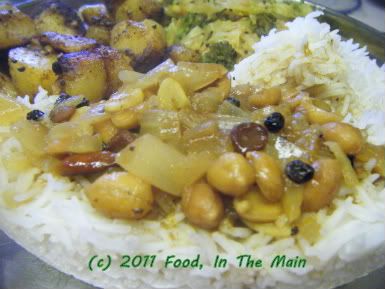 Ingredients:
2 tsp tamarind paste
4-5 cloves garlic, chopped
2 medium onions, chopped
Ingredients:
2 tsp tamarind paste
4-5 cloves garlic, chopped
2 medium onions, chopped
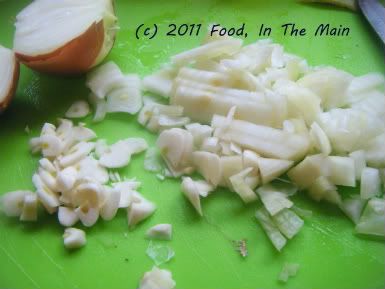 1/4 tsp vendhayam/fenugreek seeds
1 tbsp toor/tuvar dal
1 tbsp manathakkali vatthal
1 tbsp gingelly oil/nallennai
3-4 dried red chillies, broken in half (or to taste)
1 tsp mustard seeds
a few fresh/frozen curry leaves (optional)
1/2 tsp turmeric powder
1/4 tsp asafoetida powder
2-3 tsp sambar powder or vattha kuzhambu powder (if available)
2 tbsp rice flour
1/2 tsp black pepper powder
handful of roasted peanuts (optional)
Method:
1. Dissolve the tamarind paste in 5 cups water. Reserve.
2. Heat the oil and add the manathakkali vatthal, the tur dal, dried red chillies, mustard seeds, fenugreek seeds, curry leaves, asafoetida powder and turmeric powder.
1/4 tsp vendhayam/fenugreek seeds
1 tbsp toor/tuvar dal
1 tbsp manathakkali vatthal
1 tbsp gingelly oil/nallennai
3-4 dried red chillies, broken in half (or to taste)
1 tsp mustard seeds
a few fresh/frozen curry leaves (optional)
1/2 tsp turmeric powder
1/4 tsp asafoetida powder
2-3 tsp sambar powder or vattha kuzhambu powder (if available)
2 tbsp rice flour
1/2 tsp black pepper powder
handful of roasted peanuts (optional)
Method:
1. Dissolve the tamarind paste in 5 cups water. Reserve.
2. Heat the oil and add the manathakkali vatthal, the tur dal, dried red chillies, mustard seeds, fenugreek seeds, curry leaves, asafoetida powder and turmeric powder.
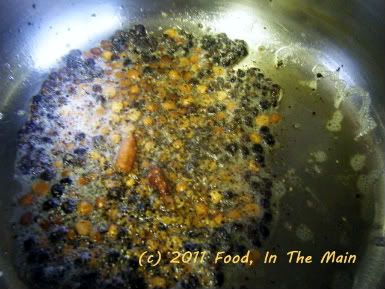 Fry all these for a couple of minutes on high heat, stirring to prevent burning.
3. Next, add the chopped onions and garlic and stir.
Fry all these for a couple of minutes on high heat, stirring to prevent burning.
3. Next, add the chopped onions and garlic and stir.
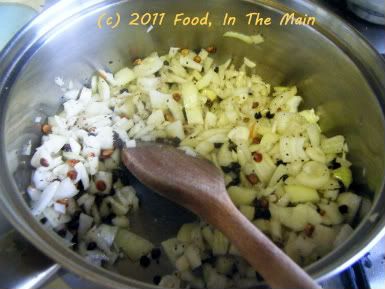 4. When the onions start to soften, add the sambar/vattha kuzhambu powder and stir it in, along with the black pepper powder.
4. When the onions start to soften, add the sambar/vattha kuzhambu powder and stir it in, along with the black pepper powder.
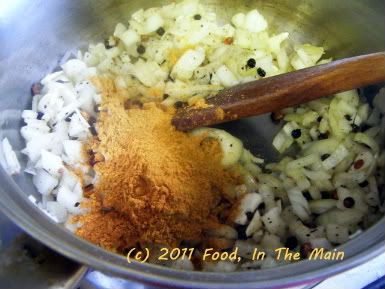 5. Now pour in the tamarind water.
5. Now pour in the tamarind water.
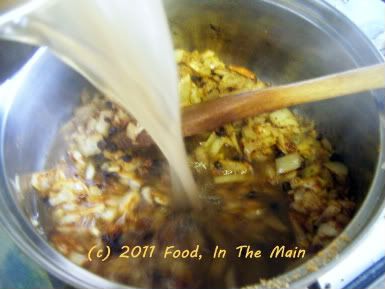 Bring to a boil on high heat, then turn it down to medium-low and let it simmer gently for 10 minutes or so.
6. Whisk together 2 tbsp rice flour with some water to make a thick, pourable paste and stir it into the kuzhambu. Let it boil for another 4-5 minutes until the kuzhambu thickens and becomes less watery.
Bring to a boil on high heat, then turn it down to medium-low and let it simmer gently for 10 minutes or so.
6. Whisk together 2 tbsp rice flour with some water to make a thick, pourable paste and stir it into the kuzhambu. Let it boil for another 4-5 minutes until the kuzhambu thickens and becomes less watery.
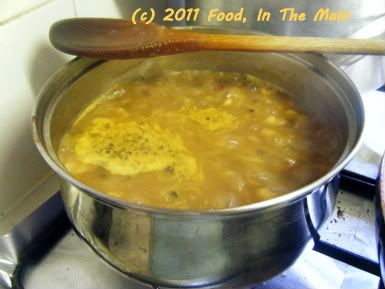 Add salt to taste and throw in the peanuts now, if using. Serve hot with steamed white rice and a dry vegetable curry.
RECIPE: VENGAYA VATTHA KUZHAMBU
Ingredients:
2 tsp tamarind paste
4-5 cloves garlic, chopped
2 medium onions, chopped
1/4 tsp vendhayam/fenugreek seeds
1 tbsp toor/tuvar dal
1 tbsp manathakkali vatthal
1 tbsp gingelly oil/nallennai
3-4 dried red chillies, broken in half (or to taste)
1 tsp mustard seeds
a few fresh/frozen curry leaves (optional)
1/2 tsp turmeric powder
1/4 tsp asafoetida powder
2-3 tsp sambar powder or vattha kuzhambu powder (if available)
2 tbsp rice flour
1/2 tsp black pepper powder
handful of roasted peanuts (optional)
Method:
1. Dissolve the tamarind paste in 5 cups water. Reserve.
2. Heat the oil and add the manathakkali vatthal, the tur dal, dried red chillies, mustard seeds, fenugreek seeds, curry leaves, asafoetida powder and turmeric powder. Fry all these for a couple of minutes on high heat, stirring to prevent burning.
3. Next, add the chopped onions and garlic and stir.
4. When the onions start to soften, add the sambar/vattha kuzhambu powder and stir it in, along with the black pepper powder.
5. Now pour in the tamarind water. Bring to a boil on high heat, then turn it down to medium-low and let it simmer gently for 10 minutes or so.
6. Whisk together 2 tbsp rice flour with some water to make a thick, pourable paste and stir it into the kuzhambu. Let it boil for another 4-5 minutes until the kuzhambu thickens and become less watery. Add salt to taste and throw in the peanuts now, if using. Serve hot with steamed white rice and a dry vegetable curry.
Add salt to taste and throw in the peanuts now, if using. Serve hot with steamed white rice and a dry vegetable curry.
RECIPE: VENGAYA VATTHA KUZHAMBU
Ingredients:
2 tsp tamarind paste
4-5 cloves garlic, chopped
2 medium onions, chopped
1/4 tsp vendhayam/fenugreek seeds
1 tbsp toor/tuvar dal
1 tbsp manathakkali vatthal
1 tbsp gingelly oil/nallennai
3-4 dried red chillies, broken in half (or to taste)
1 tsp mustard seeds
a few fresh/frozen curry leaves (optional)
1/2 tsp turmeric powder
1/4 tsp asafoetida powder
2-3 tsp sambar powder or vattha kuzhambu powder (if available)
2 tbsp rice flour
1/2 tsp black pepper powder
handful of roasted peanuts (optional)
Method:
1. Dissolve the tamarind paste in 5 cups water. Reserve.
2. Heat the oil and add the manathakkali vatthal, the tur dal, dried red chillies, mustard seeds, fenugreek seeds, curry leaves, asafoetida powder and turmeric powder. Fry all these for a couple of minutes on high heat, stirring to prevent burning.
3. Next, add the chopped onions and garlic and stir.
4. When the onions start to soften, add the sambar/vattha kuzhambu powder and stir it in, along with the black pepper powder.
5. Now pour in the tamarind water. Bring to a boil on high heat, then turn it down to medium-low and let it simmer gently for 10 minutes or so.
6. Whisk together 2 tbsp rice flour with some water to make a thick, pourable paste and stir it into the kuzhambu. Let it boil for another 4-5 minutes until the kuzhambu thickens and become less watery. Add salt to taste and throw in the peanuts now, if using. Serve hot with steamed white rice and a dry vegetable curry.
I guess I could have called this a vattha kuzhambu except for the fact that I carefully refrained from using manthakkali or chundakkai vatthal (dried berries). This puli kuzhambu tastes very nice, if you ask me. If, however, you DON'T want to ask me, I guess you'll have to make it and discover this fact for yourself, won't you?
Recipe for: Flaxseed puli kuzhambu (tamarind gravy)
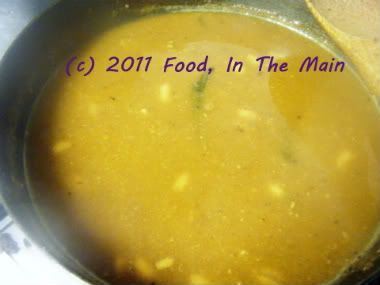 Ingredients:
2 tbsp dry-roasted flaxseeds
1 htbsp sambar powder
2 tsp rice flour
1/4 cup roasted peanuts
Lime-sized amount of tamarind/2 tsp tamarind paste
2 tsp tuvar dal
1 tsp mustard seeds
1/2 tsp vendhayam/fenugreek seeds
5-6 fresh/frozen curry leaves
1 tbsp gingelly oil/nallennai
Salt to taste
4-5 cups water
Method:
1. Pound or grind the flaxseeds to a fine powder.
Ingredients:
2 tbsp dry-roasted flaxseeds
1 htbsp sambar powder
2 tsp rice flour
1/4 cup roasted peanuts
Lime-sized amount of tamarind/2 tsp tamarind paste
2 tsp tuvar dal
1 tsp mustard seeds
1/2 tsp vendhayam/fenugreek seeds
5-6 fresh/frozen curry leaves
1 tbsp gingelly oil/nallennai
Salt to taste
4-5 cups water
Method:
1. Pound or grind the flaxseeds to a fine powder.
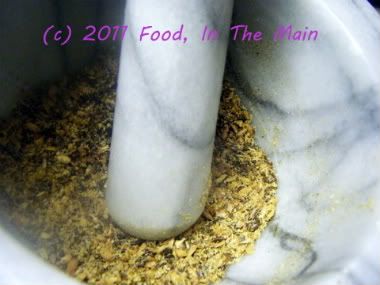 2. Dissolve the tamarind in 4 cups water (or extract the pulp from the dry tamarind). Reserve.
3. Heat the oil in a pan, add the asafoetida powder, tuvar dal, fenugreek seeds, curry leaves, and mustard seeds. Cover and let the seeds pop, let the dal turn golden brown,
2. Dissolve the tamarind in 4 cups water (or extract the pulp from the dry tamarind). Reserve.
3. Heat the oil in a pan, add the asafoetida powder, tuvar dal, fenugreek seeds, curry leaves, and mustard seeds. Cover and let the seeds pop, let the dal turn golden brown,
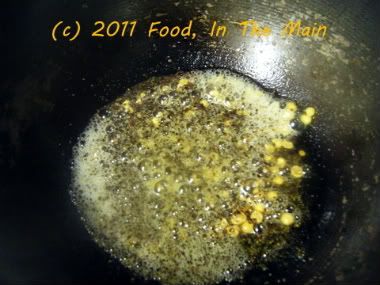 then pour in the tamarind water.
then pour in the tamarind water.
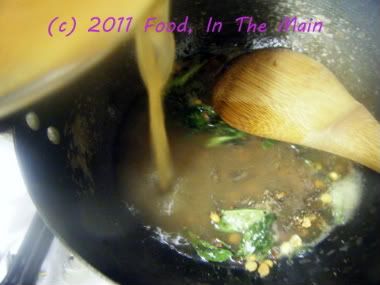 Let this come to a brisk boil.
4. While it is coming up to the boil, mix together the flaxseed powder, sambar powder and rice flour,
Let this come to a brisk boil.
4. While it is coming up to the boil, mix together the flaxseed powder, sambar powder and rice flour,
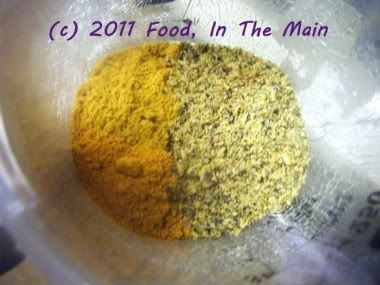 add 1/4 cup water and whisk to a pourable mixture without lumps.
add 1/4 cup water and whisk to a pourable mixture without lumps.
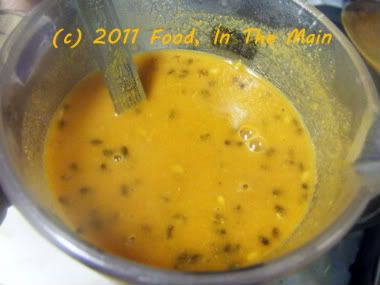 5. Now pour this into the tamarind water and stir it in, along with salt to taste.
5. Now pour this into the tamarind water and stir it in, along with salt to taste.
 6. Keep the heat on medium and let the kuzhambu simmer for 10 minutes to let the flavours come together, and for it to thicken. Then add the peanuts and allow the kuzhambu to boil for 5 minutes more.
6. Keep the heat on medium and let the kuzhambu simmer for 10 minutes to let the flavours come together, and for it to thicken. Then add the peanuts and allow the kuzhambu to boil for 5 minutes more.
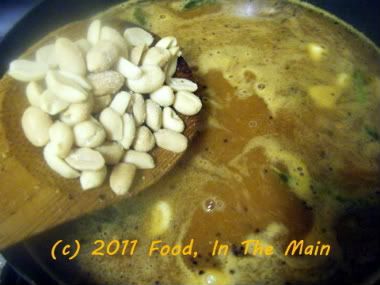 7. The longer the kuzhambu sits, the better it will taste. Reheat before serving, along with steamed rice and any kootu or vegetable curry.
RECIPE: FLAXSEED PEANUT PULI KUZHAMBU (TAMARIND GRAVY)
Ingredients:
2 tbsp dry-roasted flaxseeds
1 htbsp sambar powder
2 tsp rice flour
1/4 cup roasted peanuts
Lime-sized amount of tamarind/2 tsp tamarind paste
2 tsp tuvar dal
1 tsp mustard seeds
1/2 tsp vendhayam/fenugreek seeds
5-6 fresh/frozen curry leaves
1 tbsp gingelly oil/nallennai
Salt to taste
4-5 cups water
Method:
1. Pound or grind the flaxseeds to a fine powder.
2. Dissolve the tamarind in 4 cups water (or extract the pulp from the dry tamarind). Reserve.
3. Heat the oil in a pan, add the asafoetida powder, tuvar dal, fenugreek seeds, curry leaves, and mustard seeds. Cover and let the seeds pop, let the dal turn golden brown, then pour in the tamarind water. Let this come to a brisk boil.
4. While it is coming up to the boil, mix together the flaxseed powder, sambar powder and rice flour, add 1/4 cup water and whisk to a pourable mixture without lumps.
5. Now pour this into the tamarind water and stir it in, along with salt to taste.
6. Keep the heat on medium and let the kuzhambu simmer for 10 minutes to let the flavours come together, and for it to thicken. Then add the peanuts and allow the kuzhambu to boil for 5 minutes more.
7. The longer the kuzhambu sits, the better it will taste. Reheat before serving, along with steamed rice and any kootu or vegetable curry.
7. The longer the kuzhambu sits, the better it will taste. Reheat before serving, along with steamed rice and any kootu or vegetable curry.
RECIPE: FLAXSEED PEANUT PULI KUZHAMBU (TAMARIND GRAVY)
Ingredients:
2 tbsp dry-roasted flaxseeds
1 htbsp sambar powder
2 tsp rice flour
1/4 cup roasted peanuts
Lime-sized amount of tamarind/2 tsp tamarind paste
2 tsp tuvar dal
1 tsp mustard seeds
1/2 tsp vendhayam/fenugreek seeds
5-6 fresh/frozen curry leaves
1 tbsp gingelly oil/nallennai
Salt to taste
4-5 cups water
Method:
1. Pound or grind the flaxseeds to a fine powder.
2. Dissolve the tamarind in 4 cups water (or extract the pulp from the dry tamarind). Reserve.
3. Heat the oil in a pan, add the asafoetida powder, tuvar dal, fenugreek seeds, curry leaves, and mustard seeds. Cover and let the seeds pop, let the dal turn golden brown, then pour in the tamarind water. Let this come to a brisk boil.
4. While it is coming up to the boil, mix together the flaxseed powder, sambar powder and rice flour, add 1/4 cup water and whisk to a pourable mixture without lumps.
5. Now pour this into the tamarind water and stir it in, along with salt to taste.
6. Keep the heat on medium and let the kuzhambu simmer for 10 minutes to let the flavours come together, and for it to thicken. Then add the peanuts and allow the kuzhambu to boil for 5 minutes more.
7. The longer the kuzhambu sits, the better it will taste. Reheat before serving, along with steamed rice and any kootu or vegetable curry.






















































